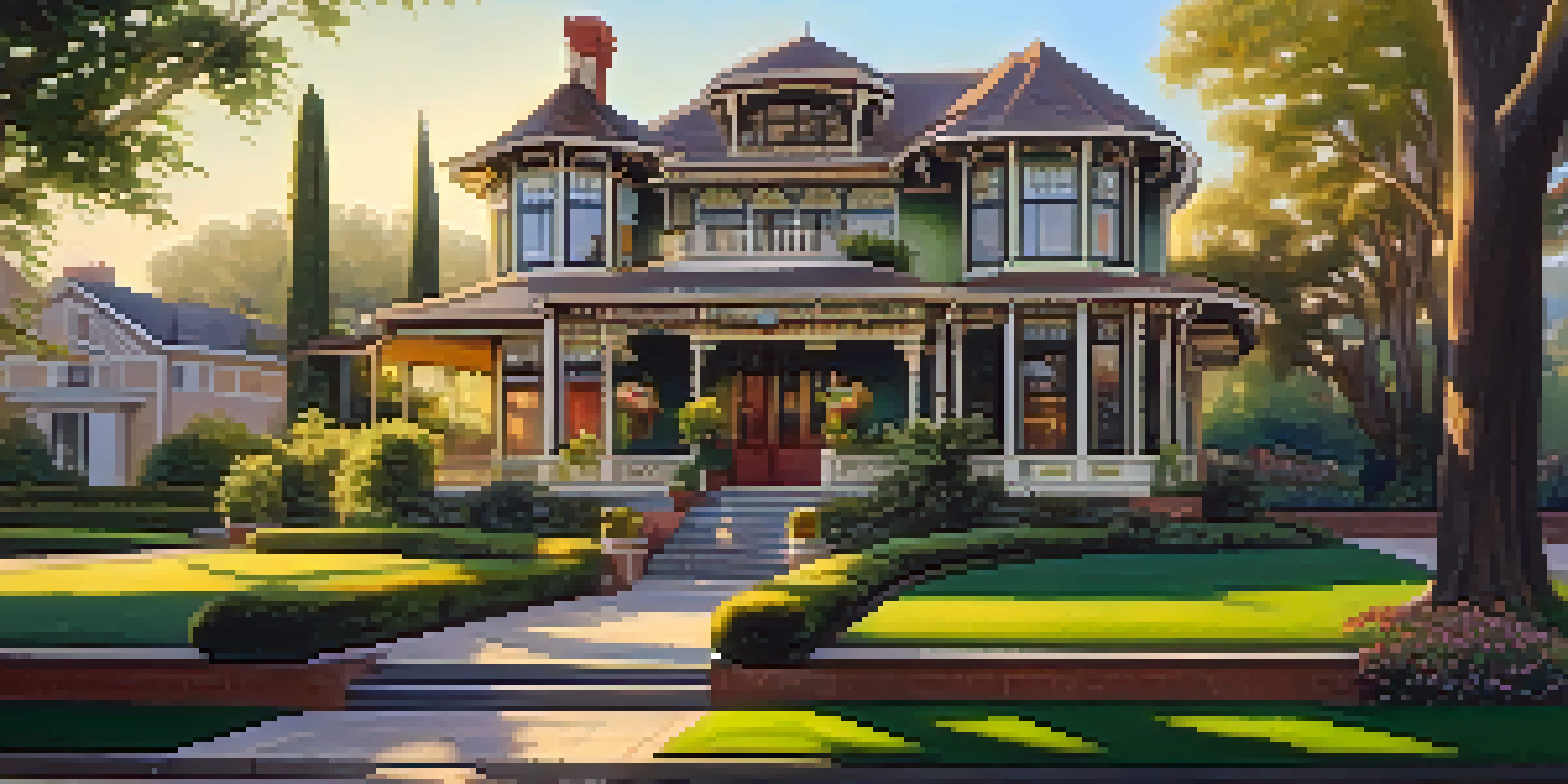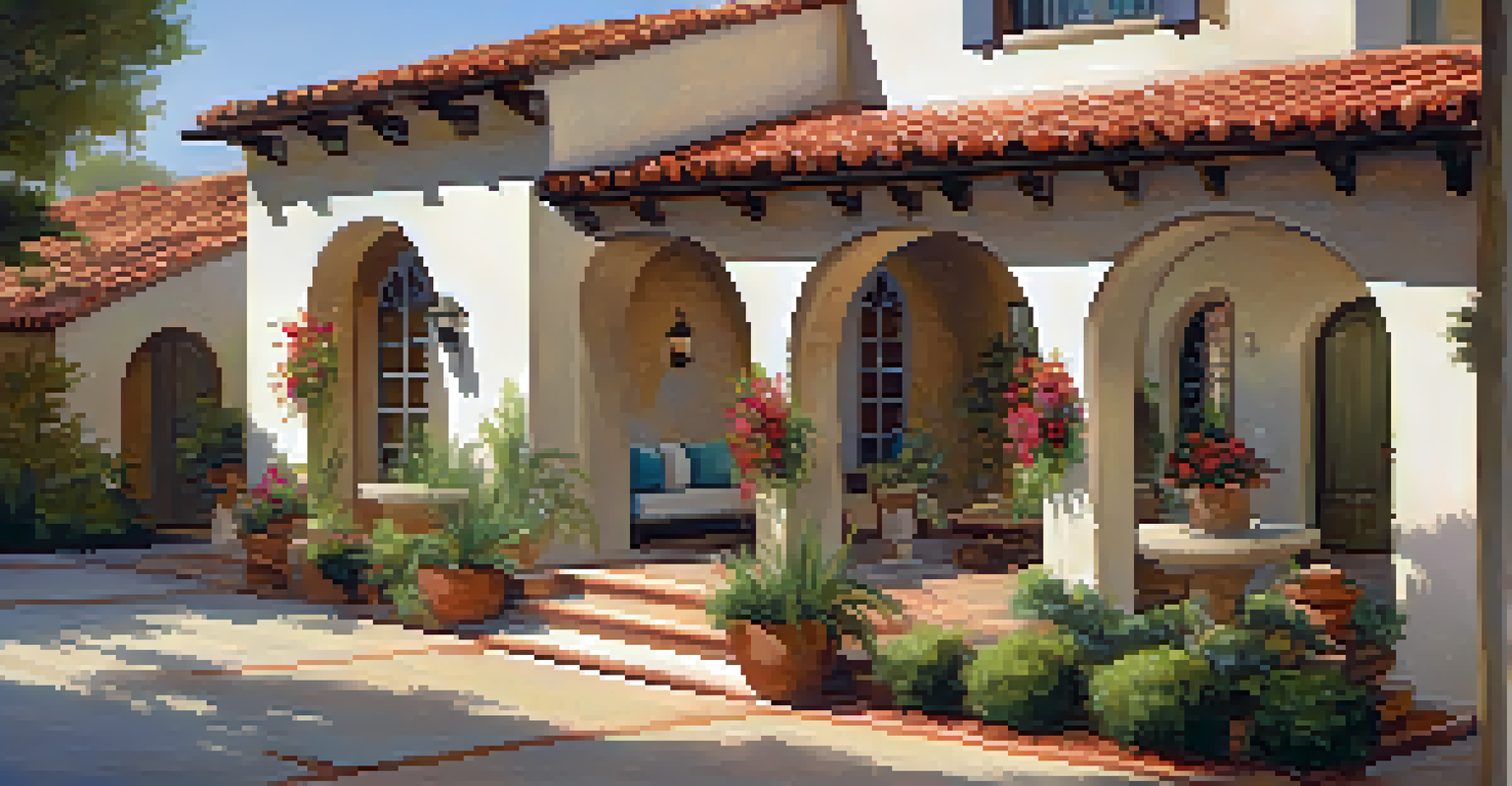The Evolution of Pasadena's Architecture Through the Decades

The Birth of Pasadena's Architectural Identity in the 1880s
In the late 19th century, Pasadena began to carve out its architectural identity, primarily driven by the influx of settlers seeking a sunny paradise. This period saw the rise of Victorian-style homes, characterized by ornate details and intricate woodwork. The Gamble House, built in 1908, is a shining example of the Arts and Crafts movement, showcasing handmade craftsmanship and harmony with nature.
Architecture should speak of its time and place, but yearn for timelessness.
Victorian architecture wasn’t just about aesthetics; it was also a reflection of the era's social dynamics. As affluent families settled in the area, they sought to showcase their wealth and status through grand homes, which contributed to the city's evolving landscape. This architectural trend set the stage for Pasadena's future developments, marrying elegance with comfort.
As we look back at this foundational period, it’s clear that the 1880s were not just about building homes; they were about creating a community. The architectural choices of the time were deeply intertwined with the social fabric of Pasadena, emphasizing the importance of place and identity in shaping a city.
The Flourishing Arts and Crafts Movement of the 1900s
The early 20th century welcomed the Arts and Crafts movement, which emphasized handmade artistry and a connection to nature. In Pasadena, this was evident in the construction of homes that prioritized natural materials and craftsmanship over mass production. The iconic Gamble House perfectly embodies this ethos, showcasing beautiful joinery and a seamless integration with the surrounding landscape.

During this time, architects like Greene and Greene rose to prominence, influencing design aesthetics not just locally but nationally. Their work emphasized simplicity and functionality, often incorporating local materials that celebrated California’s natural beauty. This shift marked a departure from the opulence of Victorian architecture, inviting a more grounded approach to home design.
Pasadena's Architectural Evolution
From Victorian homes to modern designs, Pasadena's architecture reflects its cultural and social transformations over the decades.
The Arts and Crafts movement's impact extended beyond residential architecture, influencing public spaces and institutions. As Pasadena embraced this style, it laid the groundwork for future architectural trends while fostering a sense of community and connection to the environment.
The Rise of the Mediterranean Revival Style in the 1920s
By the 1920s, Pasadena was ready for a new architectural chapter: the Mediterranean Revival style. This trend was inspired by the sunny climate and the romantic allure of Southern European architecture, featuring stucco exteriors, red-tiled roofs, and arched doorways. Buildings like the Pasadena City Hall became iconic representations of this style, emphasizing elegance and charm.
The best buildings come from a deep understanding of place, context, and climate.
The Mediterranean Revival movement was not just about aesthetics; it represented a lifestyle that celebrated leisure and the outdoors. Homes were designed to blend indoor and outdoor living, often surrounded by lush gardens and courtyards. This approach resonated with the growing population of Pasadena, who sought tranquility in their suburban lives.
As this architectural style flourished, it symbolized a period of prosperity and cultural exchange in Pasadena. The blending of different influences created a unique aesthetic that distinguished Pasadena from other California cities, reinforcing its identity as a premier destination.
Streamlined Designs of the 1930s: Art Deco Influence
The 1930s brought about a fascination with the Art Deco movement, known for its bold geometric shapes and streamlined forms. In Pasadena, this style was evident in commercial buildings and theaters, such as the historic Pasadena Playhouse, which showcased the era's love for modernity and sophistication. Art Deco emphasized a sense of forward-thinking that resonated during the Great Depression.
Architects began to explore new materials and construction techniques, blending traditional styles with modern elements. The use of chrome, glass, and polished surfaces marked a shift in design philosophy, reflecting the optimism of the time. This architectural evolution was not just about aesthetics but also about redefining how spaces could function.
Emphasis on Community and Heritage
The preservation efforts in Pasadena highlight the importance of community involvement in maintaining the city's architectural identity.
As Art Deco flourished, it added a layer of complexity to Pasadena’s architectural tapestry. The blend of classicism with modernity created a dynamic environment, showcasing the city's adaptability and willingness to embrace change.
Post-War Modernism: A Shift in Architectural Philosophy
After World War II, Pasadena experienced a significant architectural transformation with the rise of modernism. This movement focused on simplicity, functionality, and a rejection of ornamentation, creating spaces that felt open and airy. Homes in this style often featured flat roofs, large windows, and an emphasis on indoor-outdoor living, reflecting the changing lifestyles of post-war families.
Architects like Richard Neutra and Gregory Ain were at the forefront of this movement, designing homes that harmonized with their surroundings. Their work emphasized sustainability and efficiency, incorporating innovative materials and construction methods. This shift mirrored a broader cultural change as people sought practicality in the wake of the war.
The modernist era left a lasting impact on Pasadena, establishing the city as a hub for innovative design. These architectural choices not only shaped the skyline but also influenced how residents interacted with their spaces, fostering a sense of community and connection.
Revival and Preservation: 1970s to Today
Starting in the 1970s, Pasadena began to embrace its architectural heritage, leading to a wave of preservation efforts. The city recognized the value of its historic buildings and sought to maintain the unique character that had developed over the decades. This revival was essential in protecting landmarks like the Old Pasadena district, which showcases a blend of various architectural styles.
As the movement towards preservation gained momentum, it brought to light the importance of community involvement and awareness. Residents became advocates for their neighborhoods, ensuring that the rich history of Pasadena was not lost to modernization. This grassroots effort has helped sustain the city’s charm and authenticity.
Sustainability in Modern Design
Contemporary architecture in Pasadena merges traditional styles with sustainable practices, demonstrating a commitment to environmental responsibility.
Today, Pasadena stands as a testament to its diverse architectural journey, blending old and new in a harmonious way. The preservation efforts of the past have allowed the city to thrive while honoring its history, making it a vibrant place for residents and visitors alike.
Contemporary Trends: A Fusion of Styles and Sustainability
In recent years, Pasadena has embraced contemporary architectural trends that emphasize sustainability and innovation. Modern architects are blending traditional designs with eco-friendly practices, creating buildings that not only look good but also minimize their environmental impact. This fusion reflects a growing awareness of climate change and the importance of responsible design.
The use of energy-efficient materials, green roofs, and solar panels are just a few examples of how contemporary architecture in Pasadena is evolving. These designs prioritize functionality while respecting the city’s historical context, resulting in a unique architectural landscape that is both modern and rooted in tradition. This shift signifies a commitment to the future without sacrificing the past.

As Pasadena continues to grow, its architectural narrative remains dynamic and ever-changing. The blend of contemporary style and historical preservation speaks to the city's resilience and vision, ensuring that its architectural evolution is as rich and varied as its culture.